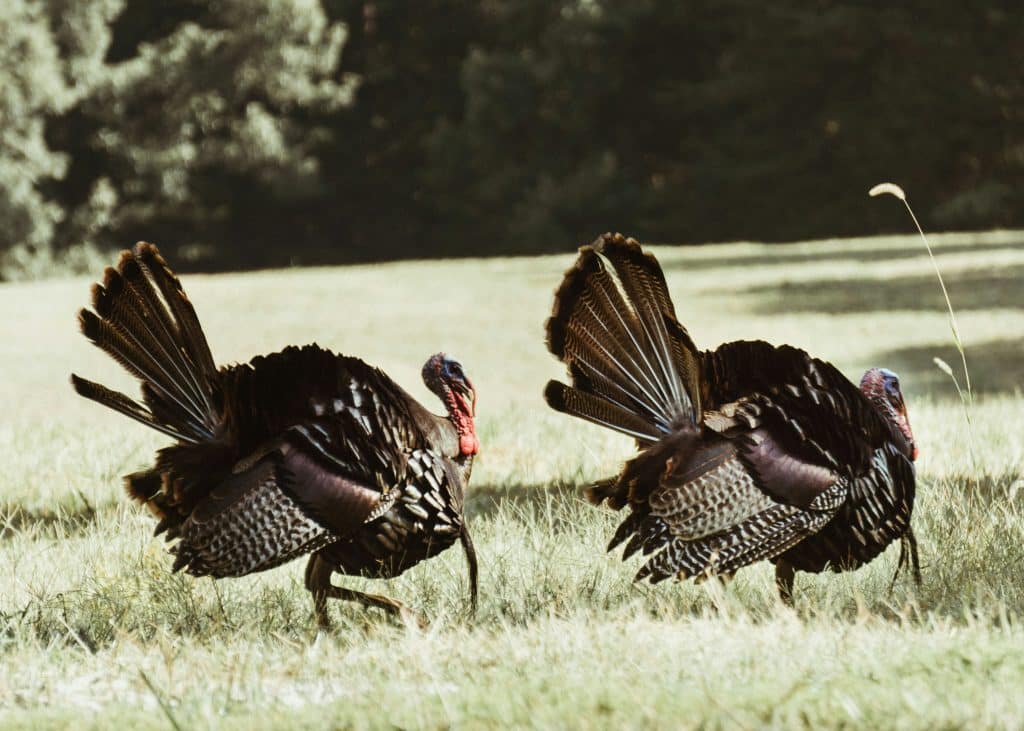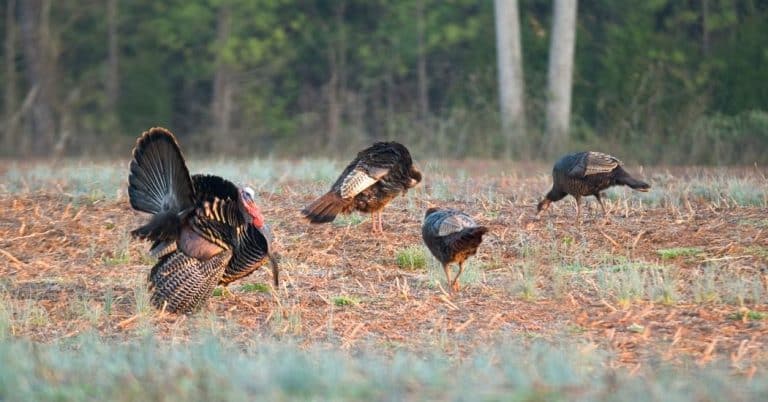Evening turkey hunting wasn’t always an option for hunters. Years ago, many states limited hunting hours to mornings only, ending at noon and this included my home state of Pennsylvania. Today, many states allow hunting until sunset, opening up new opportunities for those who can’t make early morning hunts or want to maximize their time in the field.
You might wonder if evening hunting is worth your time compared to the morning hours. The answer is a resounding yes. Evening hunts offer unique advantages, including less hunting pressure and different turkey behavior patterns that can work in your favor. Let’s dive into strategies that will help you fill your tag as the sun dips low.
Understanding Evening Turkey Behavior
Turkeys act differently in the evening than they do at dawn and instead of explosive energy and vocal displays, they gradually wind down, focusing on feeding before heading to roost. Since they’re more relaxed, they’re more predictable.
In the evening, birds that spread out during the day begin to regroup. Hens and toms that separate often come back together, moving as larger flocks toward roosting areas. By mid-afternoon, around 3:30-4:00, turkeys typically start feeding heavily, needing to fuel up before the overnight fast.

What makes evening birds particularly huntable is their tendency to follow the same paths day after day if they aren’t pressured. Learn these patterns, and you’ll be several steps ahead of other hunters.

Scouting for Evening Success
Success in evening hunting starts with solid scouting and you need to know where birds roost and feed, plus the routes they travel between these locations.
This is where a quality trail camera really comes into play for evening turkey hunting. Place them along field edges, near water sources, or in suspected feeding areas. Check them regularly or use cellular models to minimize disturbance while gathering intelligence on turkey movements.
Make scouting trips before the season, arriving several hours before sunset. Watch from a distance using binoculars or a spotting scope. Note exactly where birds fly up to roost, what time they arrive at these areas, and the paths they take to get there.
Pay special attention to what turkeys are doing 1-2 hours before roosting. Are they gathered in specific fields? Do they follow the same ridge or creek bed? Identifying these patterns gives you the blueprint for setting up your hunt.
Mobile Hunting Tactics
Evening birds cover lots of ground, so a run-and-gun approach often works best. This mobile style keeps you in the game when birds aren’t responding to calls from one location.
Set up and call for about ten minutes in a promising spot and if you don’t get a response, pick up and move to the next location. This keeps you from wasting precious evening hours in unproductive areas.
Your gear selection is pretty important for evening turkey hunting as well. Get yourself a good turkey vest with a built-in kickstand seat that lets you quickly set up anywhere comfortable. Keep calls organized and accessible, carry minimal decoys, and have water handy.
Before leaving any setup, use your compact binoculars to thoroughly scan the area. Birds might be silently working toward you, especially in the evening when they’re less vocal. Nothing feels worse than spooking a turkey you never saw coming in your direction as you’re picking up to move.
Strategic Setup Locations
Placement is everything for late afternoon turkey hunting. Position yourself between feeding areas and known roost sites, but not too close to the roost trees themselves. About 100-150 yards from a roost offers the sweet spot where you can intercept birds without spooking them.
Field edges make excellent evening setups since turkeys love to feed in open areas before heading to roost, making fields natural gathering spots as daylight fades. Water sources also attract birds in the evening, especially during dry periods.
Look for funnels and pinch points where terrain naturally channels turkey movement. Saddles between ridges, creek crossings, and gaps in thick cover often serve as turkey highways in the evening.
When hunting pressured public land, seek out overlooked spots away from parking areas and obvious roost sites. The areas other hunters ignore often hold turkeys that have adjusted their patterns to avoid hunting pressure.
Calling Strategies for Evening Hunts
Your calling approach should shift for evening hunts. Morning calling can be loud and aggressive to locate birds, but evening calling typically works better when subtle and realistic.
Soft clucks, purrs, and feeding sounds match what real turkeys do in the evening. These calls of content signal to passing birds that everything’s normal and safe. When calling to turkeys heading to roost, less is often more.
That said, don’t be afraid to challenge a hen if the situation calls for it. Sometimes the dominant hen will bring the entire flock—toms included—to investigate an intruder. Sharp cutting and excited yelping can trigger this territorial response.
Evening gobbles usually happen when toms are trying to gather their hens before roosting or when a lone tom is searching for company. When you hear an evening gobble, move quickly but carefully toward it, because that bird is likely ready to commit.
Decoy Strategies
Evening decoy setups differ from morning tactics. A jake and hen combo works particularly well, triggering dominance in lone toms looking for one last breeding opportunity before dark.
Consider lightweight, portable decoys for evening hunting when you might be covering ground. Montana Decoy and other brands make excellent mobile options that fold flat in your vest yet deploy quickly when needed.
Position decoys where approaching turkeys can easily spot them from a distance. Open areas with good visibility work best for evening setups. Place them 15-20 yards from your position, giving birds a clear stopping point within shooting range.
As light begins to fade, be ready to adjust your decoy placement. Birds approaching roost areas may change their travel routes, requiring you to quickly reposition to stay in the game.

Special Tactics for Pressured Birds
Hunting turkeys in the evening presents unique opportunities for dealing with pressured birds. The reduced hunting activity after lunchtime means birds often let their guard down compared to mornings.
For call-shy toms, consider setting up an ambush along travel routes without calling at all. Simply position yourself along paths birds use to return to roost and wait patiently.
Use hen behavior to your advantage with pressured birds. Toms might ignore your calls, but they’ll follow hens heading to roost. If you can irritate or interest a boss hen with your calling, she might bring the whole flock—tom included right to you.
Pressured birds often roost earlier than unpressured ones. Be prepared for this by getting to your evening setup with plenty of daylight remaining. The best time to hunt turkey in the evening often starts earlier than you might expect, sometimes 3-4 hours before sunset.
Planning for Success
The beauty of evening hunting is that it creates opportunities for the next morning. If unsuccessful in the evening, you’ll know exactly where birds roosted, giving you perfect intel for a dawn setup.
Weather heavily influences evening bird behavior. On clear, calm evenings, turkeys often stay in open areas longer and during windy or rainy conditions, they typically head to roost earlier and may use different routes for protection.
Start your evening hunt at least 3-4 hours before sunset, giving yourself time to work multiple setups if needed. Late afternoon turkey hunting typically produces best results when you’re already positioned well before birds begin moving toward roost.
Safety becomes increasingly important as light fades. Know exactly when legal shooting hours end in your area and give yourself plenty of margin. It’s not worth risking a violation or an unsafe shot in dim conditions.
Respecting the Roost
How to roost a turkey in the evening involves careful observation without disturbance. Position yourself where you can see turkeys fly up without being detected. Use binoculars and remain absolutely still as birds settle in for the night.
Once birds are roosted, back out carefully without spooking them. Mark the exact trees they’re using (mentally or on apps like OnX) for future reference. This information is gold for morning hunts.
FAQs
Do turkeys gobble in the evening?
Yes, turkeys do gobble in the evening, though typically less frequently than in the morning. Evening gobbling often happens when toms are trying to gather their hens before roosting or when a lone tom is searching for company.
If you hear gobbling in the evening, it usually indicates a bird that’s ready to commit to a call. Evening gobbles tend to be more meaningful—when a tom talks, he’s often willing to walk.
How to roost a turkey in the evening?
To roost a turkey in the evening:
- Position yourself at a distance (200+ yards) with a clear view of likely roost areas
- Arrive 1-2 hours before sunset to watch birds approach
- Remain completely still and use binoculars to observe
- Listen for wing flaps as birds fly up
- Note exact trees where birds settle
- Back out in the opposite direction without disturbing them
- Mark locations mentally or on GPS for morning hunting, mark with apps like OnX
- Avoid getting too close or making noise that might spook them
This information becomes invaluable for planning the next morning’s hunt, as you’ll know precisely where to set up before dawn.
Wrap Up
Evening turkey hunting offers rewards that morning-only hunters miss. The changing dynamics of birds preparing for nightfall create unique opportunities for those willing to adapt their strategies.
The keys to success lie in understanding evening behavior patterns, staying mobile, using subtle calling, and respecting the birds’ natural cycles. With patience and practice, you’ll find that those golden hours before sunset can be just as productive as dawn.
Remember that evening hunts connect perfectly with morning strategies in a continuous cycle. Even unsuccessful evening hunts provide valuable intelligence for the next morning’s setup. This continuity makes evening hunting an essential part of any complete turkey hunting strategy.
Per our affiliate disclosure, we may earn revenue from the products available on this page. To learn more about how we test gear, click here.



